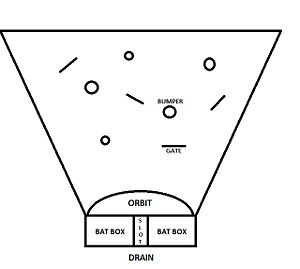Silverball
| Silverball | |
|---|---|

| |
| Designer: | Adam Nelson |
| Year: | unknown |
| Players: | 10-20 |
| Stuff required: | Two baseball bats. At least three kickballs. At lease 20 field cones. |
| Crew required: | One. |
| Preparation: | Ten minutes. |
| Time required: | An hour. |
| Place required: | A grassy hill with a few trees and a gentle slope. |
| Activities: | Running, kicking, batting, teamwork, hitting, pinball, new sport |
| This is a playable game - it's finished, tested and ready to play. | |
| This game is made available under an Attribution-Noncommercial Creative Commons licence. (What does this mean?) | |
Soccer meets baseball meets human-sized pinball. Ever since I was a young man, I played that silverball...
History and Influences
Silverball was invented by Adam Nelson and members of Obscure Games Pittsburgh. It was first played in Mellon Park, Pittsburgh, on May 6, 2010. It is influenced by baseball, soccer, and pinball.
Silverball was also the winner of "Best New Sport" at the 2010 Come Out and Play Festival in Brooklyn, New York.
Playing Space
Silverball is played on a the side of hill. The terrain of the hill determines the location of "bumpers" (trees), and gates are spread randomly through the playing field. The bottom of the field is 18 feet wide, and the width of the top of the field can be up to 100 feet wide. The field is about 100 feet long from top to bottom.
Other dimensions:
- The Drain is 18 feet wide and 6 feet deep.
- Each Bat Box is 8 feet wide.
- The Slot is 2 feet wide.
- The Orbit is 6 feet at its highest point.
- Gates are 6 feet long.
Number of Players
Two teams of 5-8 players each. 6 players per team is ideal.
Gameplay and Rules
Silverball is played over three innings, during which each team has a turn at offense and defense. On offense, each team has three credits (balls) to use. They may use these credits at any time (i.e., the team may have up to three balls in play at any time). The offensive team makes points by kicking the balls through the gates and off the bumpers, as well as using baseball bats to defend the drain and keep balls in play. The defensive team attempts to block and steal the balls and kick them through the drain, causing the credit to expire and the ball to be out of play. Once all credits are out, teams switch positions.
Rules
Positions
1. There are two teams and three positions; Flippers, Poppers, and Knockers. Flippers and Poppers make up the offensive team. Knockers make up the defensive team.
2. Flippers stand within the Bat Box and are the only players who may use bats.
- A flipper may not cross the Slot, and may not take the bat out of the Bat Box (See Tilts and Other Faults).
- A flipper is the only player who may enter the Orbit. Within the orbit, he may use his hands to recover a ball, but may not enter the Bat Box with the ball. Instead, he must toss the ball to the other flipper, who bats it back into play. This is known as a "Trap."
- A flipper may only enter the Orbit once the ball has crossed into the Orbit.
- A flipper must use a bat to return a ball to the field. He may not kick or toss a ball back into the field.
3. Poppers and Knockers play on the field, using their feet to kick the ball, and hands to slap or dribble. Throwing and catching is not allowed.
- Poppers and Knockers may not enter the Orbit. (See Tilts and Other Faults)
Scoring
4. Points are scored when a ball passes through a gate, or bounces off a bumper. Gates score 1000 points, and Bumpers 100 points. The ball must pass through a gate or bounce off of a bumper at or below waist level.
5. Flippers score a Jackpot of 3000 points by hitting the ball past the upper boundary of the field.
6. Game play does not stop after points are scored.
7. Knockers remove credits by kicking the ball through the Drain. Once a credit has expired a flipper "plunges" another ball by batting it into play. When three credits have been removed, teams switch positions.
Multiball
8. At the beginning of each round, the offensive team begins with three credits (balls) that they may use at any time. Consequently, at any point during the round a flipper may plunge one or two additional balls into play, creating a multiball game. Once plunged, the balls must remain in play until they are expired by the defensive team (by kicking them through the drain). Expired balls may not be brought back into play.
Tilts and other Faults
9. A Tilt is a fault that occurs when a ball is kicked out of bounds. A Tilt can be committed by either team. Once a ball is kicked out of play, the last player to touch the ball must retrieve it, while a flipper immediately plunges a new ball into play.
10. A Full Tilt is a fault committed by one of the flippers, which occurs when a ball is batted out of play (i.e. when a ball is stuck or hit in such a way that the game is delayed). When a Full Tilt is committed, a credit expires and a new ball must be plunged into play.
11. An Orbit Fault occurs when a player enters the Orbit to make the following actions:
- A popper enters the Orbit to bock a shot by a knocker.
- A knocker enters the Orbit while shooting at the Drain.
- A popper or knocker runs through the Orbit.
- A flipper enters the Orbit while in possession of a bat, or carries a ball from the orbit into the Bat Box.
In each of the cases above, the team who commits the Orbit Fault loses 1000 points.
End of Game
12. The game ends after 3 innings (a period of 2 rounds, during which each team plays offense and defense). The team with the most points wins. If already in the lead after the penultimate round, the final offensive team may elect not to play the final round.
Additional Resources
- A PDF of the Silverball Rules, to hand out.

